Electric paint circulation pumps: why brushless DC motors are better than AC motors
BLDC electric circulation pumps in paint systems enable optimal efficiency, control and performance.
Electric pumps require some sort of electric motor to convert the electric power into mechanical power to drive the circulation pump motor. AC induction motors and brushless DC (BLDC) motors are the most common. Discover why BLDC motors are better than AC motors.
Pneumatic pumps have been the mainstay of the paint circulation world for many years, and for good reason. They are simple, reliable and inherently safe for hazardous paint kitchens with solvent-based paints.
However, they have one important disadvantage: high energy consumption. Running at an efficiency of only 10%, the 24/7 use of pneumatic motors can really add up in energy expenses. Due to the inefficiency of pneumatic pumps, the market has been moving towards other solutions such as electrically driven reciprocating pumps.
Types of electrical motors
Electric paint pumps require some sort of electric motor to convert the electric power into mechanical power to drive the pump. There are different types of electric motors used in the industry; however, AC induction motors and brushless DC (BLDC) motors are the most common.
For most general industrial applications, AC induction motors are the more popular choice. They are simple, cost-effective and, if there is not a requirement for speed control, they do not require any sort of control. BLDC motors do require a controller and have become more common since the availability of low-cost power electronics, which started in the late 1970s.
Differences between AC and BLDC circulation pump motors
AC induction motors and BLDC motors are very similar; the primary difference is in the construction of the rotor. An AC induction motor does not have any magnets on the rotor; instead it has a series of laminations and windings. When three-phase power is applied to the stator of the motor, a rotating magnetic field is generated. This rotating magnetic field creates a current flow in the rotor via induction. The rotor current creates its own magnet that interacts with the stator field and generates torque.
AC motor with variable frequency drive (VFD)
Most AC induction motors can be run directly off AC power with no controller. If variable speed is required, as in many pump applications, this advantage is eliminated. In this case a variable frequency drive (VFD) is required.
The VFD changes the speed of the motor by altering the frequency of the power provided to the motor. For example, a motor rated at 1800 rpm and 60 Hz can be slowed down to 900 rpm by running it at 30 Hz. Even with a VFD, industrial AC induction motors have a limited speed range of about 30 to 130% of rated speed. They are not optimal for delivering rated torque at very low speeds or when stalled.
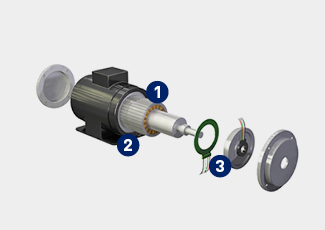
BLDC Motor Components
(1) Stator (2) Rotor with permanent magnets
(3) Shaft encoder
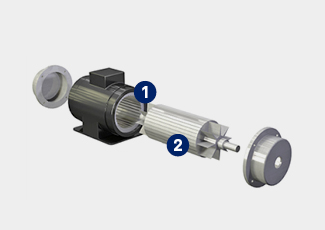
AC Motor Components
(1) Stator (2) Rotor with windings
Advantages of a brushless DC (BLDC) motor
With AC induction motors being more common than BLDC motors, why would operators select a BLDC motor for a pump application? There are several advantages and features that only a BLDC can offer, including:
- Higher efficiency: A BLDC motor reduces power consumption and heat generation.
- Precise control of torque and speed: A pump can respond rapidly to changes in system demand. The pump can also be ‘deadheaded’, which allows the motor to generate full torque at zero speed. Additionally, the motor can generate constant torque. This allows the motor to be controlled to create constant pressure, which reacts to changes in a circulation system similar to a pneumatic pump.
- Lower rotor inertia: This results in considerably faster pump response to changes in system pressure than a similarly powered AC induction motor.
- Smaller size: For any given power output, BLDC motors are typically smaller than AC motors, which also allows the pump to be smaller.
The improved efficiency of BLDC motors can be seen in the following graphs. Graph 1 compares AC induction motors to BLDC motors. Graph 2 shows the total electrical to mechanical efficiency of various types of circulation pump.
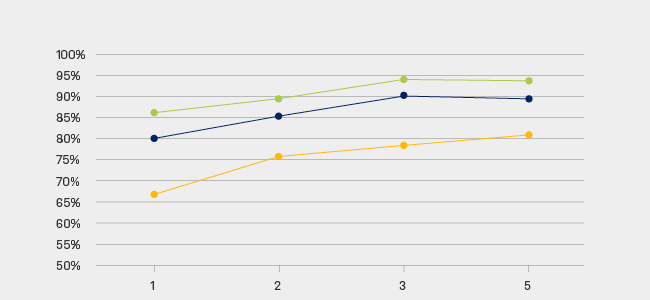
Graph 1: Power efficiency
Horsepower
(green) BLDC motor (blue) 3-phase AC motor (yellow) 1-phase AC motor
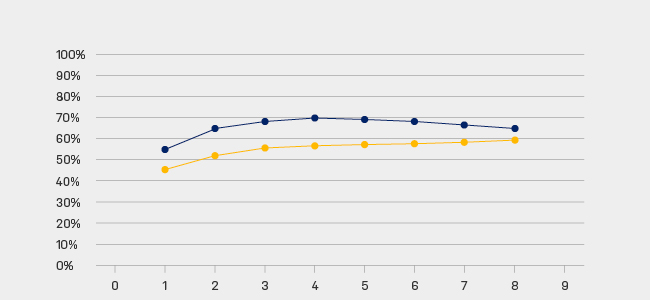
Graph 2: Flow efficiency
Fluid flow (gpm)
(blue) Electric circulation pump with BLDC motor (yellow) Electric circulation pump with AC motor
AC motors require a complicated setup
AC and BLDC motors both require a method to convert the rotary motion of the motor to the linear reciprocating motion of a positive displacement piston pump. An AC induction motor’s relatively constant speed operation and slow dynamic response require a complicated mechanical mechanism to accomplish this. For example, a cam or yoke arrangement may be used.
Below is an example of an AC induction motor-driven pump. Notice how the AC motor, gearbox and cam drive system are all separate and required to covert the rotary motion to linear motion. The cam drive system consists of multiple parts and is two to three times larger than the actual motor. They also have wear points and bearings that can easily break or wear out and require costly maintenance or replacement.
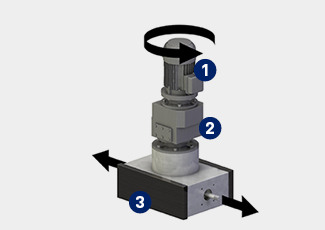
Motor circulation AC motor
(1) AC motor (2) Speed-reducing gearbox (3) CAM
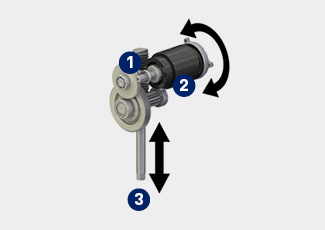
Motor circulation BLDC motor
(1) BLDC motor (2) Rack & pinion drive system
(3) No mechanism required with a BLDC motor
Why simpler is better
In addition to the lower inertia and better torque control, a BLDC motor’s inherently fast response allows the mechanical connection to be significantly simplified.
In comparison with the large setup of an AC induction motor-driven pump, a paint circulation pump system may use a small BLDC motor, two-stage gear reduction and a simple rack-and-pinion drive system to convert the rotary motion to linear motion.
To create the reciprocating action, the direction of rotation of the BLDC motor is simply reversed. With lower inertia and precise torque control, the BLDC motor makes this simple and efficient.
Conclusion
Implementing BLDC electric pumps in paint circulation systems allows operators to achieve optimal efficiency, control and performance. Additionally, with easy connection capability and quiet operation, BLDC electric pumps improve work environments, with quieter operation, allowing operators to remain near the pump to ensure continuous performance.
Related Articles
Reduce energy consumption and costs with electric paint mixing pumps
Electric paint mixing pumps help manufacturers to reduce energy consumption and operating costs.
5 significant advantages of robot painting
The advantages of automated painting: reduce costs and waste and improve flexibility and quality.
How to achieve the best results with electrostatic spray painting guns
5 simple steps to get the best finish quality and transfer efficiency with electrostatic sprayers.




